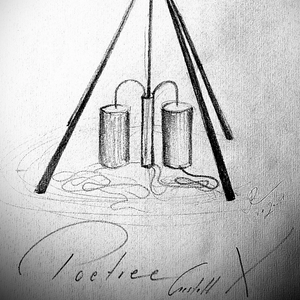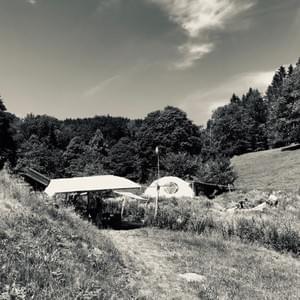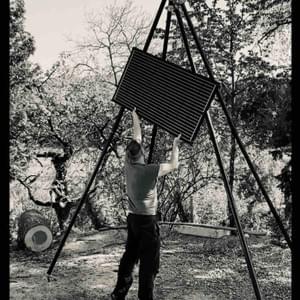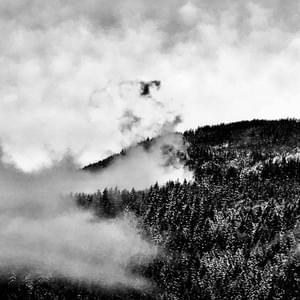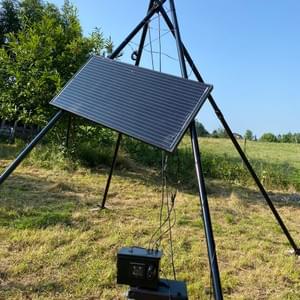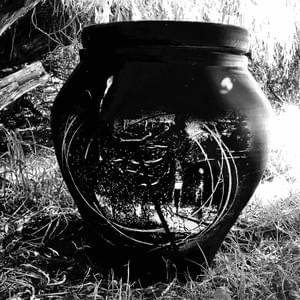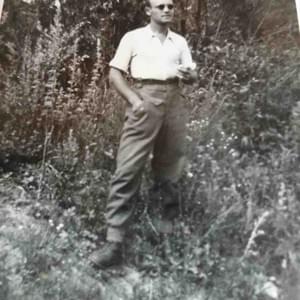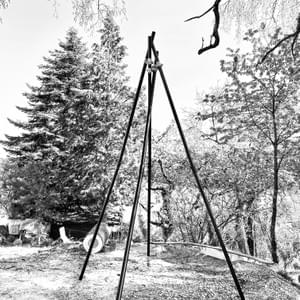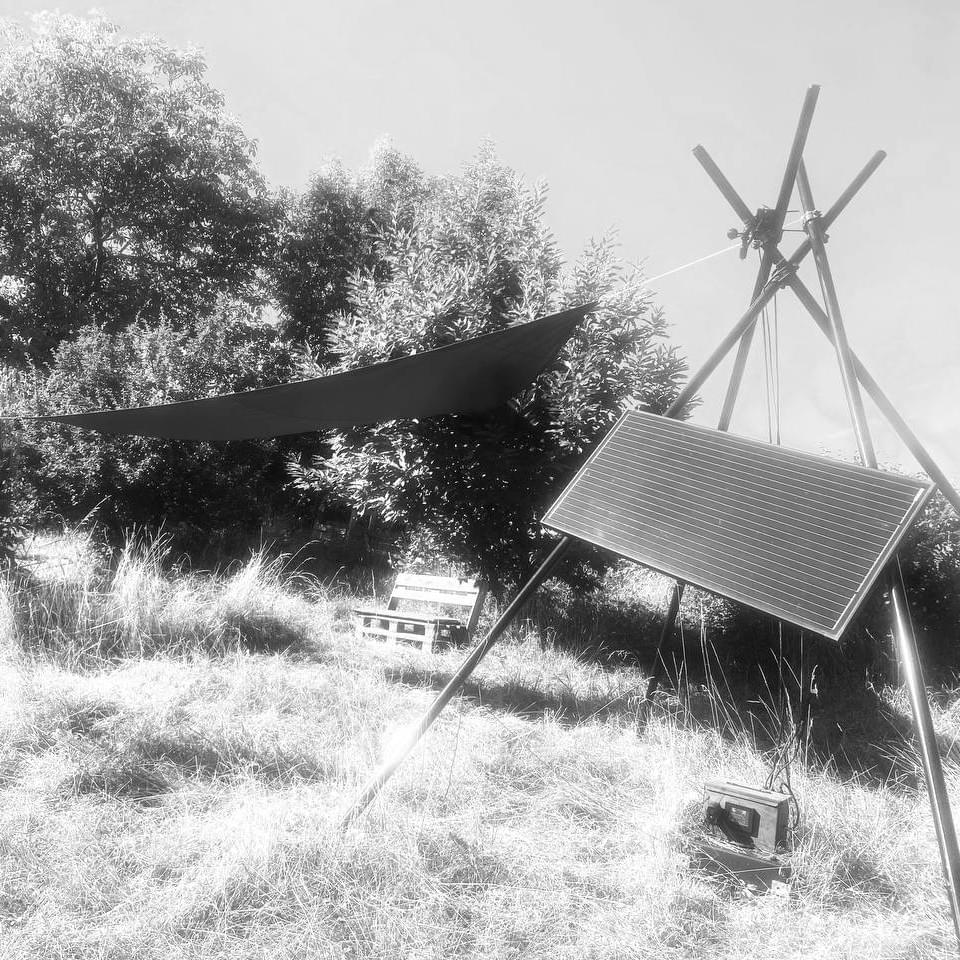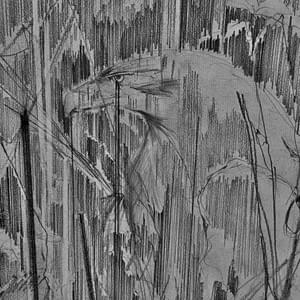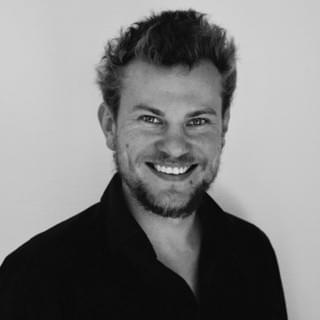
Poetree Gestell X
Towards a conversation between Paul Celan and Martin Heidegger
How It Works
Building the Gestell X
1Backbone
The Gestell X is mobile, solar powerd, and wind-sensitiv due to an Aneometer. The project is inspired by Julian Olivers HARVEST. It was supported by the SEEDS crypto community.
2Digital Poesis
Currently, Heidegger and Celan's work is analyzed and used to generate a possibility to ask them question. We are useing a language model transformer (GTP-NEO). A first prototype exists: https://celan-heidegger-api.glitch.me.
3POETree
Linked to the wind the program starts to generate a QR-Code - scan it and you are entering the virtuell Gestell where you can ask Celan or Heidegger a question. What answers will emerge?
4Swarm IQ
People can support the project through the SEEDS cryptocurrency. Enabling them to co-create and discuss the emerging dialouge.
5(E)volution
With time the Decentralized Autonomous Installation (DAI) will evolve, be supported through more Seeds. This will allow to install more progamms, to purchase more microphones, cameras, programmers...the installation evolves...
Black Forest Metamodernism – Dissolving the Traumata of Modernity
Black Forest Metamodernism addresses the existential underneath of the traumata of modernity. It realises the red thread leading out of the meaning crises, out of the postmodern labyrinth. It explores the hidden connection of fear and care in Heidegger’s philosophy and the marriage of instrumental rationality and romanticism ultimately leading to the traumatisation of modernity. It follows the postmodern angst of the labyrinth, rejecting any red thread leading into irony and the contemporary meaning crisis. Yet, going deep, realising the existentiality of love as an existential choice provides an opening of transcendence dissolving the traumata not only of modernity.
The postmodern labyrinth
‘Post Post what?’
‘Pozt Poztmodern Angzt Dizorder. It iz quvite common. Ur zymptoms r quvite clazzic.’
‘What are you talking about, Doc?’
‘U r experienzink—or rather, continuouzly re-experienzink zhe Poztmodernizt Angzt ov zhe Labyrinth.’
(Postpostmodern Angst Disorder – Metamodernist Poetry, M. H. Frost)‘Modernity betrayed us. It broke the promises of progress and lead straight into the culminating catastrophes of the Second World War and the Holocaust. And when that was over, we were left in the void, in a maze of a thousand questions. It is the postmodern labyrinth, an essentially posttraumatic response to modernity’s failure. It is a place where we have not overcome the modern condition and at the same time are trapped in the post-postmodern angst disorder not knowing what comes after it. It is a void that evokes a horror vacui, a fear of that very void.
To understand this struggle and the meaning crisis of the 20th century, we have to go to a dark place, literally the Black Forest. To dissolve the trauma of modernity, we have to start with the most controversial German, if not western, philosopher Martin Heidegger and the most important Jewish-Hungarian poet after Auschwitz Paul Celan. The silence between them, the absence of dialogue is our entry point into the void of the labyrinth. The work of Martin Heidegger can be seen as a bottleneck between modern and postmodern philosophy. His book ‘Being and Time’ defined the tone for many philosophical traditions afterwards. His influence can be traced in phenomenology, hermeneutics, existentialism, deconstructionism, or literary theory, all of which dominated the postmodern discourse. With the death of God and the death of traditional, metaphysical philosophy, Heidegger’s work is a crucial starting point of the postmodern age, conceived, radicalised, and written in his cottage in the Black Forest.
Heidegger’s existential phenomenology directly confronted the meaning crisis at the beginning of the 20th century. In Heidegger’s view, we are not beings with an essence. We are essentially beings with no essence on a continuous quest through questioning to live into being. For Heidegger the only certainty is death. We are thrown into the world – into Dasein– we are ‘being towards death’ in time. What do you care for? This is the question that defines your being in the world towards death. You have to choose how to spend your time to become aware of being. Otherwise, you fall into meaninglessness, your life framed by instrumental rationality. This is the existential threat of our limited existence. Heidegger reflects this threat in the German word Sorge. It translates into English as worry, anxiety or care.
The world, following Heidegger, is suffused with and built on fear. Care is built on fear. It is this realisation that marked a threshold of the meaning crises: No mythical, or metaphysical, or religious red thread can lead you out of the labyrinth.
The community of care
‘My azzociate, Herr Daedalus, zuccumbed to political prezzure und twizted reazon und zcience to deztructive purpozez. Zhis created zhe unbalanze und gave birth to zhe Minotaur.’
(Postpostmodern Angst Disorder: Metamodernist Poetry von M. H. Frost)National socialism was a community of care. National socialism was in a certain way an ideology of Sorge. On one side of the coin ‘anxious’ of the other, the jew, the homosexual, and the impure. On the other side full of ‘care’ for its own people, the land, the community, the Volkskörper. The Nazi’s ultimate concern was to only care for the German race and its survival, constantly feeling the threat of defeat by (imagined) enemies. As pointed out by the metamodern Danish philosopher Hanzi Freinacht, national socialists embarked on a journey of care using progressive ideas, avant-garde art movements like Futurism, taking down social hierarchies, giving workers more rights, and minimum wages. Ultimately, they had an intimate understanding of how to generate mass positive feelings to unite a Volk behind one cause.
Heidegger joined the Nazi party in 1933, attempting to become a thought leader of the fascist regime. His participation has something fundamentally to do with his own philosophy. From the start, it was always more than a theory. Heidegger’s philosophy was an existentialist project of care (Sorge). Heidegger realised how through philosophy and metaphysics we have lost ourselves in the labyrinth. He dared to let go of those old attempts to find a way back. But on the other side could not handle the void, the horror vacui of the meaning crises, what we call the labyrinth. The existential threats and fears became the only thread there was for him at the peak of the meaning crisis in the last century.
Fear is a mind killer, don’t confuse it with strength, a strength the alt-right and fascist movements pretend to have. In Europe today 30 000 000 million people voted for Populist right-wing parties as the Austrian linguist Ruth Wodak pointed out in her book ‘The Politics of Fear‘. Too many confuse threat with a thread and navigate by fear. Again, fascism was and is an ‘ideology of care’ (and anxiety). It is ultimately integrated and driven by fear.
What filled the void of the labyrinth in 1933 was the unleashing of the beast in the labyrinth: The marriage of cold rationality and idealistic romanticism. This was giving the Nazi regime technological and scientific powers never seen before and a deep sense of meaning and community. While idealism in its origin was a brave attempt, and to some extent succeeded to challenge cold rationality, in the end, it led towards a spiritual bypass, a form of escapism, and a backwards-oriented ideology: an ‘absolutism of feeling’ and interior states over rationality. Neither the objective-external experience of empiricism as the only valid form of perception nor the subjective-inner romanticism proved a way out of the labyrinth. The minotaur was born and, as the Greek myth goes, the beast was hungry (not only) for young men.
The existentiality of love
‘Yez: zhiz vill not be eazy.
Zhe ztate ov dizcomvort zhat iz zhe Poztmodern Angzt can become zhe comvort.
Und u vace zhe pozzibility ov dizcoverink zhat u r not zhe Dheseus u zhought u vere,
und zhat zhe vactz r var more bloody und horrible zhen u know.’
(Postpostmodern Angst Disorder – Metamodernist Poetry, M. H. Frost)To arrive at Black Forest Metamodernism, we need to understand this ontological frozenness of postmodernity. After Auschwitz, the Algerian-born French philosopher Jacque Derrida, one of the most influential figures of postmodern philosophy, finally ushered in a new way of being in the labyrinth. Rather than working to find a red thread, he deconstructed the idea of it. Where Heidegger demands a decision, confusing thread with threat, Derrida sticks with what is in-between being and ‘beings. Heidegger’s difference of being and beings evolved into Derrida’s ironic différance. While Heidegger demands a decision towards being through facing your anxiety and looming death, Derrida stays in the no-man’s land, precisely in-différant. It is the birthplace of postmodern irony. The sincerity of the fundamental existential decision is postponed – the discomfort of modern angst becomes the postmodern place of comfort.
As Black Forest Metamodernism we assume another possibility: One that takes courage, the ability to see through the distortion of fear or distress and to act accordingly. It is the courage to let yourself fall into love. It is in a way a decision for love as formulated by the Jewish scholar and philosopher Michael Chighel in his commentary on Heidegger. The root of it is a non-cosmic vertical alignment, the ability to enter through existentialism not with Sorge but with love as a structurally transcending force. The only real one there is. As outlined by the Austrian Jewish and Israeli philosopher Martin Buber in his Hebrew humanism, it is not built on mythopoetic metaphysics but the I-Thou relationship inherent in the experience of human beings. Where Heidegger moves into the isolation of being to find some form of freedom, the decision we take is to realise the love inherent in nothingness itself. The void that Heidegger and postmodern thinkers opened gives way to the existentiality of love as a new option and red thread in the labyrinth.
The existential underneath
‘How can that thread help me now? I’ve long since lost that thread.’
‚Und zhat iz zhe problem. Ve muzt re-dizcover zhat dhread!‘
(Postpostmodern Angst Disorder – Metamodernist Poetry, M. H. Frost)The decision of love today is not easy. Our collective traumatised memories come more and more painful to the surface. We collectively have to numb this pain, to dissociate from it in one form or the other. Trauma is not the enemy, on the contrary, the trauma patterns helped us to survive collectively. Unfortunately, today collective trauma memories stand in the way. And yet they might be the best teachers to enter the existentiality of love to ground metamodernism in being.
Paul Celan’s poetry here was and still is an entry point, a practice of a certain sensibility. He was able to give language to the atrocities in a way that made poetry after Auschwitz possible again. A core quality of his art, as well as good art in general, is to stay with the numbness and absence of the collective until it moves creatively into a cultural artefact, enabling resonance with the frozenness inside of us, sometimes violently breaking or gently melting the ice around our minds and hearts. He was not interested in transcending but to become a lighting root of the pain through his particular art form. To stay with the absence, to presence the absence is key. Today we need to sense what is missing between the trauma of modernity and post(traumatic)modernism.
For Black Forest Metamodernism this is as much an artistic practice and process as it is a contribution to metamodern philosophy. To oscillate between presence and absence, to become aware of the traumatised collective memories we embody might give each one of us a new piece of the red thread. Polyvagal theory gives us today powerful insight into the importance of embodied love. Our nervous system is grown through co-regulation. Interpersonal neurobiology shows us that we are not only living in relationships but are defined by relationships even biologically. We are wired to have beautiful relationships with ourselves, others, and life itself. With love, beautification can be found even in the trauma of the meaning crises. Love is a structurally transcending force. It dissolves what comes into its way.
After all, it was the lover of Theseus in the minotaur myth that gave him the red thread. We cannot find this thread alone; it grows from one heart to another heart. Black Forest Metamodernism is therefore not the cultural in-between, the political after, or the mystical beyond. Black Forest Metamodernism addresses the existential underneath. It makes the invisible visible. To dissolve the trauma of modernity means to ground, compost, and heal the post-postmodern angst disorder together collectively. In the end, Black Forest Metamodernism is about realising the existentiality of love.
European School of Governance, position paper # 211219-1 by Adrian Wagner

Black Forest Axioms
"Simplicity is not the opposite of complexity - it is reductionism." Hedè van Dekker
Transcontextual Fluidity
Localized Response-Ability
Hybrid poetics
Aesthetic Politics
Global Social Witnessing
Progressive Conservatism
Transcendental Realism
Prior Unity
A Journey into the woods....
"There is something in the forest, it keeps wisphering." her grandfather said.
Inner Circle
Founder of the Black Forest Metamodern School

Hedé van Dekker
Founder
Artist & Philosopher Queen
"My heritage goes back to a almost forgotten, and always discret Belgium-Dutch aristocratic lineage. One of my great-great-great-grandfather made a fortune with black forrest wood - Building ships to conqueror the world. But he left a seceret in those woods, passed on through generation - and it has yet to be discovered."
Hedé loves walks in solitue around Todtnau. Contemplating being and searching for a door to the future through changing the past in the present moment.

Adrian
Wagner
Founder
Writer & Researcher
"I am grateful to have met Hedè van Dekker in Kyiv at the metamodern art festival. My grandfather lived close to the place where Celan's sister died. Serving Hedè van Dekker through writing is an honor. Protecting her through poetry, a real adventure."
Adrian loves to spin ideas, to plant them into the future and to grow up into those realities one day at a time. He truly believes that only poetry will safe humanity in the coming decades ahead.
Privacy Policy
Personal data (usually referred to just as "data" below) will only be processed by us to the extent necessary and for the purpose of providing a functional and user-friendly website, including its contents, and the services offered there.
Per Art. 4 No. 1 of Regulation (EU) 2016/679, i.e. the General Data Protection Regulation (hereinafter referred to as the "GDPR"), "processing" refers to any operation or set of operations such as collection, recording, organization, structuring, storage, adaptation, alteration, retrieval, consultation, use, disclosure by transmission, dissemination, or otherwise making available, alignment, or combination, restriction, erasure, or destruction performed on personal data, whether by automated means or not.
The following privacy policy is intended to inform you in particular about the type, scope, purpose, duration, and legal basis for the processing of such data either under our own control or in conjunction with others. We also inform you below about the third-party components we use to optimize our website and improve the user experience which may result in said third parties also processing data they collect and control.
Our privacy policy is structured as follows:
I. Information about us as controllers of your data
II. The rights of users and data subjects
III. Information about the data processingI. Information about us as controllers of your data
The party responsible for this website (the "controller") for purposes of data protection law is:
Adrian Wagner
Heimbachhof 1
79280 Au
Germany
Phone: 017699782297
Email: adrian.wagner@humboldt-viadrina.org
The controller's data protection officer is:
Adrian Wagner
Heimbachhof 1
79280 Au
Germany
Phone: 017699782297
Email: adrian.wagner@humboldt-viadrina.org
II. The rights of users and data subjects
With regard to the data processing to be described in more detail below, users and data subjects have the right
- to confirmation of whether data concerning them is being processed, information about the data being processed, further information about the nature of the data processing, and copies of the data (cf. also Art. 15 GDPR);
- to correct or complete incorrect or incomplete data (cf. also Art. 16 GDPR);
- to the immediate deletion of data concerning them (cf. also Art. 17 DSGVO), or, alternatively, if further processing is necessary as stipulated in Art. 17 Para. 3 GDPR, to restrict said processing per Art. 18 GDPR;
- to receive copies of the data concerning them and/or provided by them and to have the same transmitted to other providers/controllers (cf. also Art. 20 GDPR);
- to file complaints with the supervisory authority if they believe that data concerning them is being processed by the controller in breach of data protection provisions (see also Art. 77 GDPR).
In addition, the controller is obliged to inform all recipients to whom it discloses data of any such corrections, deletions, or restrictions placed on processing the same per Art. 16, 17 Para. 1, 18 GDPR. However, this obligation does not apply if such notification is impossible or involves a disproportionate effort. Nevertheless, users have a right to information about these recipients.
Likewise, under Art. 21 GDPR, users and data subjects have the right to object to the controller's future processing of their data pursuant to Art. 6 Para. 1 lit. f) GDPR. In particular, an objection to data processing for the purpose of direct advertising is permissible.
III. Information about the data processing
Your data processed when using our website will be deleted or blocked as soon as the purpose for its storage ceases to apply, provided the deletion of the same is not in breach of any statutory storage obligations or unless otherwise stipulated below.
Social media links via graphics
We also integrate the following social media sites into our website. The integration takes place via a linked graphic of the respective site. The use of these graphics stored on our own servers prevents the automatic connection to the servers of these networks for their display. Only by clicking on the corresponding graphic will you be forwarded to the service of the respective social network.
Once you click, that network may record information about you and your visit to our site. It cannot be ruled out that such data will be processed in the United States.
Initially, this data includes such things as your IP address, the date and time of your visit, and the page visited. If you are logged into your user account on that network, however, the network operator might assign the information collected about your visit to our site to your personal account. If you interact by clicking Like, Share, etc., this information can be stored your personal user account and possibly posted on the respective network. To prevent this, you need to log out of your social media account before clicking on the graphic. The various social media networks also offer settings that you can configure accordingly.
The following social networks are integrated into our site by linked graphics:
Facebook
Facebook Ireland Limited, 4 Grand Canal Square, Dublin 2, Ireland, a subsidiary of Facebook Inc., 1601 S. California Ave., Palo Alto, CA 94304, USA.
Privacy Policy: https://www.facebook.com/policy.php
LinkedIn
LinkedIn Ireland Unlimited Company, Wilton Plaza, Wilton Place, Dublin 2, Irland, a subsidiary of LinkedIn Corporation, 1000 W. Maude Avenue, Sunnyvale, CA 94085 USA.
Privacy Policy: https://www.linkedin.com/legal/privacy-policy
Instagram
Facebook Ireland Limited, 4 Grand Canal Square, Dublin 2, Ireland, a subsidiary of Facebook Inc., 1601 S. California Ave., Palo Alto, CA 94304, USA.
Privacy Policy: https://help.instagram.com/519522125107875
Facebook plug-in
Our website uses the plug-in of the Facebook social network. Facebook.com is a service provided by Facebook Inc., 1601 S. California Ave, Palo Alto, CA 94304, USA. In the EU, this service is also operated by Facebook Ireland Limited, 4 Grand Canal Square, Dublin 2, Ireland, hereinafter both referred to as "Facebook."
The legal basis is Art. 6 Para. 1 lit. f) GDPR. Our legitimate interest lies in improving the quality of our website.
Further information about the possible plug-ins and their respective functions is available from Facebook at
https://developers.facebook.com/docs/plugins/
If the plug-in is stored on one of the pages you visit on our website, your browser will download an icon for the plug-in from Facebook's servers in the USA. For technical reasons, it is necessary for Facebook to process your IP address. In addition, the date and time of your visit to our website will also be recorded.
If you are logged in to Facebook while visiting one of our plugged-in websites, the information collected by the plug-in from your specific visit will be recognized by Facebook. The information collected may then be assigned to your personal account at Facebook. If, for example, you use the Facebook Like button, this information will be stored in your Facebook account and published on the Facebook platform. If you want to prevent this, you must either log out of Facebook before visiting our website or use an add-on for your browser to prevent the Facebook plug-in from loading.
Further information about the collection and use of data as well as your rights and protection options in Facebook's privacy policy found at
https://www.facebook.com/policy.php
Shariff social media buttons
Our website uses the plug-ins of the following social networks. To integrate these plug-ins, we use the Shariff plug-in.
The legal basis is Art. 6 Para. 1 lit. f) GDPR. Our legitimate interest lies in improving the quality of our website.
Shariff is an open source program developed by c't and heise. By integrating this plug-in, linked graphics prevent the following social network plug-ins from automatically establishing a connection to the respective social networks server when you visit website(s) on which the plug-ins are integrated. Only if you click on one of these linked graphics will you be forwarded to the service of the respective social network. Only then will information about your use of our site be recorded by the respective social network. This information may include your IP address, the date and time you visited our site, as well as the pages you viewed.
If you are logged in to one of the social network services while visiting one of our plugged-in websites, the information collected by the plug-in from your specific visit will be recognized by the provider of that social network and assigned to your personal user account there and/or publish information about your interaction with our site there. If, for example, you use the a share button for the social network, this information may be stored in your user account there and published on the platform of the respective social network provider. To prevent this, you must either log out of the social network before clicking the graphic or make the appropriate settings in your social network account.
Further information about Shariff is available at
http://www.heise.de/ct/artikel/Shariff-Social-Media-Buttons-mit-Datenschutz-2467514.html
The following social networks are integrated into our website:
Google+ operated by Google Ireland Limited, Gordon House, Barrow Street, Dublin 4, Irland
Privacy information is available at https://policies.google.com/privacy
Facebook operated by Facebook Inc, 1601 S. California Ave, Palo Alto, CA 94304, USA, operated within the EU by Facebook Ireland Limited, 4 Grand Canal Square, Dublin 2, Ireland.
Privacy information can be found at https://www.facebook.com/policy.php
Twitter operated by Twitter Inc, 795 Folsom St., Suite 600, San Francisco, CA 94107, USA.
Privacy information can be found at https://twitter.com/privacy
YouTube
We use YouTube on our website. This is a video portal operated by YouTube LLC, 901 Cherry Ave, 94066 San Bruno, CA, USA, hereinafter referred to as "YouTube".
YouTube is a subsidiary of Google Ireland Limited, Gordon House, Barrow Street, Dublin 4, Irland, hereinafter referred to as "Google".
We use YouTube in its advanced privacy mode to show you videos. The legal basis is Art. 6 Para. 1 lit. f) GDPR. Our legitimate interest lies in improving the quality of our website. According to YouTube, the advanced privacy mode means that the data specified below will only be transmitted to the YouTube server if you actually start a video.
Without this mode, a connection to the YouTube server in the USA will be established as soon as you access any of our webpages on which a YouTube video is embedded.
This connection is required in order to be able to display the respective video on our website within your browser. YouTube will record and process at a minimum your IP address, the date and time the video was displayed, as well as the website you visited. In addition, a connection to the DoubleClick advertising network of Google is established.
If you are logged in to YouTube when you access our site, YouTube will assign the connection information to your YouTube account. To prevent this, you must either log out of YouTube before visiting our site or make the appropriate settings in your YouTube account.
For the purpose of functionality and analysis of usage behavior, YouTube permanently stores cookies on your device via your browser. If you do not agree to this processing, you have the option of preventing the installation of cookies by making the appropriate settings in your browser. Further details can be found in the section about cookies above.
Further information about the collection and use of data as well as your rights and protection options in Google's privacy policy found at
https://policies.google.com/privacy
Model Data Protection Statement for Anwaltskanzlei Weiß & Partner
© 2019

